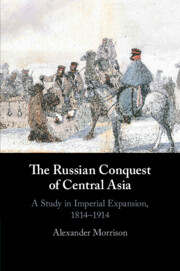Book contents
- The Russian Conquest of Central Asia
- The Russian Conquest of Central Asia
- Copyright page
- Dedication
- Contents
- Illustrations
- Maps
- Tables
- Acknowledgements
- Note on Translation, Transliteration and Dates
- Abbreviations
- Glossary
- Maps
- Introduction
- 1 Russia’s Steppe Frontier and the Napoleonic Generation
- 2 ‘Pray for the Camels’: The Winter Invasion of Khiva, 1839–41
- 3 ‘This Particularly Painful Place’: The Failure of the Syr-Darya Line as a Frontier, 1841–63
- 4 From Ayaguz to Almaty: The Conquest and Settlement of Semirechie, 1843–82
- 5 The Search for a ‘Natural’ Frontier and the Fall of Tashkent, 1863–5
- 6 War with Bukhara, 1866–8
- 7 The Fall of Khiva, 1872–3
- 8 ‘Those Who Should Be Spared’: The Conquest of Ferghana, 1875–6
- 9 ‘The Harder You Hit Them, the Longer They Will Be Quiet Afterwards’: The Conquest of Transcaspia, 1869–85
- 10 Aryanism on the Final Frontier of the Russian Empire: The Exploration and Annexation of the Pamirs, 1881–1905
- Epilogue: After the Conquest
- Sources and Bibliography
- Index
5 - The Search for a ‘Natural’ Frontier and the Fall of Tashkent, 1863–5
Published online by Cambridge University Press: 19 November 2020
- The Russian Conquest of Central Asia
- The Russian Conquest of Central Asia
- Copyright page
- Dedication
- Contents
- Illustrations
- Maps
- Tables
- Acknowledgements
- Note on Translation, Transliteration and Dates
- Abbreviations
- Glossary
- Maps
- Introduction
- 1 Russia’s Steppe Frontier and the Napoleonic Generation
- 2 ‘Pray for the Camels’: The Winter Invasion of Khiva, 1839–41
- 3 ‘This Particularly Painful Place’: The Failure of the Syr-Darya Line as a Frontier, 1841–63
- 4 From Ayaguz to Almaty: The Conquest and Settlement of Semirechie, 1843–82
- 5 The Search for a ‘Natural’ Frontier and the Fall of Tashkent, 1863–5
- 6 War with Bukhara, 1866–8
- 7 The Fall of Khiva, 1872–3
- 8 ‘Those Who Should Be Spared’: The Conquest of Ferghana, 1875–6
- 9 ‘The Harder You Hit Them, the Longer They Will Be Quiet Afterwards’: The Conquest of Transcaspia, 1869–85
- 10 Aryanism on the Final Frontier of the Russian Empire: The Exploration and Annexation of the Pamirs, 1881–1905
- Epilogue: After the Conquest
- Sources and Bibliography
- Index
Summary
For some historians the conquest of Central Asia begins in 1865 with the fall of Tashkent to General M. G. Chernyaev. In fact this was the culmination of a series of steppe campaigns which had begun in the 1840s, but it did mark the point at which the Russian empire moved from the steppe to the settled zone of Southern Central Asia. Tashkent was Central Asia’s largest city and a major trading entrepôt, but it has long been argued that Chernyaev disobeyed orders when he captured the city. This chapter demonstrates that Chernyaev’s apparent disobedience was really a product of the ambiguity of his instructions, and above all of Russian ignorance of the geography of the region, which meant the War Ministry was convinced a ‘natural frontier’ would somehow present itself when it was needed. After Aulie-Ata, Chimkent and Turkestan had fallen to Russian forces, Chernyaev was instructed to separate Tashkent from the influence of Khoqand. While not quite the daring coup de main of legend, Chernyaev’s assault was risky, and resulted in two days of fighting in the streets before he reached an accommodation with the Tashkent ‘ulama. However, it was still unclear whether Tashkent would remain in Russian hands, or be turned into a city-state under Russian protection.
- Type
- Chapter
- Information
- The Russian Conquest of Central AsiaA Study in Imperial Expansion, 1814–1914, pp. 216 - 254Publisher: Cambridge University PressPrint publication year: 2020



